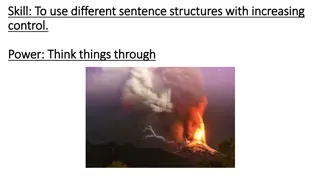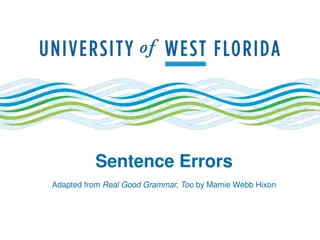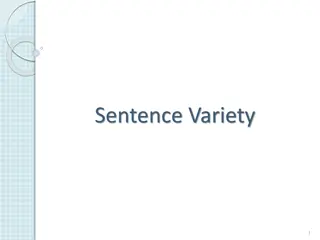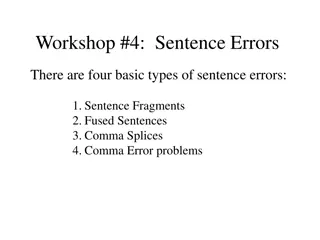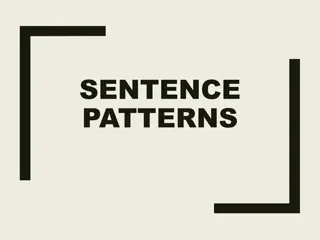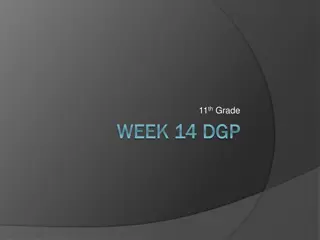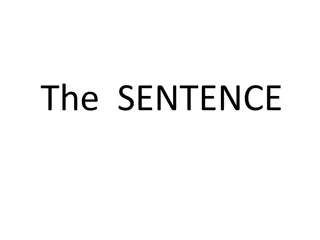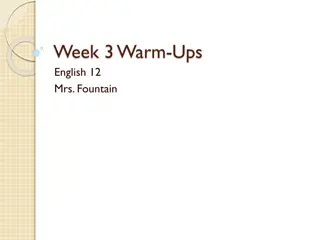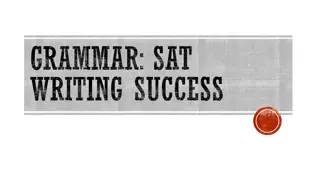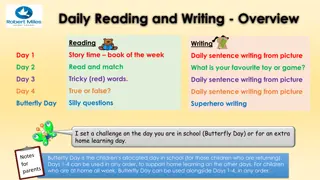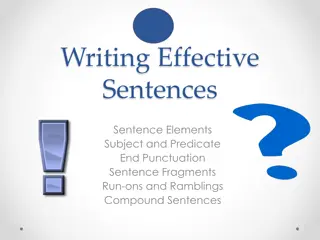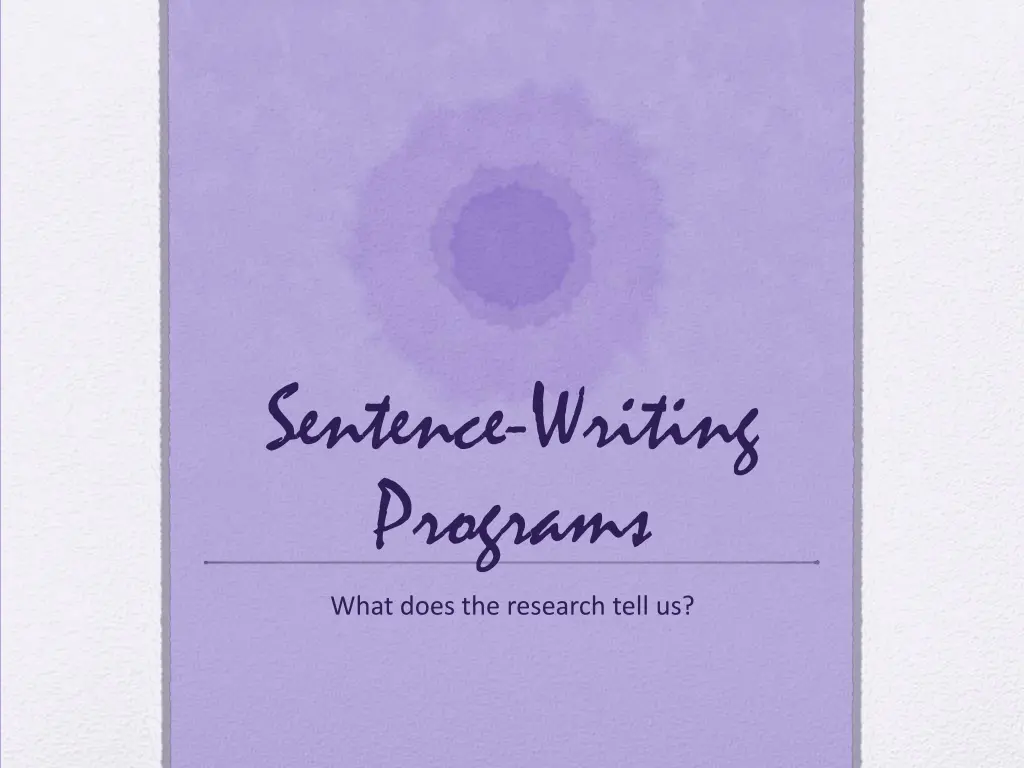
Enhancing Writing Skills through Empirically Validated Programs
Discover the effectiveness of research-based sentence writing programs and the importance of statistical, effect, and social significance in program evaluation. Explore validated instructional methods, including writing frames and strategic instruction, to improve sentence structure and comprehension skills.
Uploaded on | 0 Views
Download Presentation

Please find below an Image/Link to download the presentation.
The content on the website is provided AS IS for your information and personal use only. It may not be sold, licensed, or shared on other websites without obtaining consent from the author. If you encounter any issues during the download, it is possible that the publisher has removed the file from their server.
You are allowed to download the files provided on this website for personal or commercial use, subject to the condition that they are used lawfully. All files are the property of their respective owners.
The content on the website is provided AS IS for your information and personal use only. It may not be sold, licensed, or shared on other websites without obtaining consent from the author.
E N D
Presentation Transcript
Sentence-Writing Programs What does the research tell us?
Definitions Research based program A program containing a package of instructional methods, some of which have been shown to be effective (e.g., reinforcement). Empirically validated program A program which has been validated in a methodologically sound research study which has been published.
Three Ways to Determine Value Statistical significance Effect size Social significance
Statistical Significance Probability is less than .05 that two groups are the same
Cohens d Effect Size d = .2 to .4 is small d = .5 to .7 is medium d = above .8 is large
Eta Squared Effect Size Large effect = .14 or larger Medium effect = .06 to .13 Small effect = .01 to .05
Social Significance Use what you know about the world to make a decision about whether something is socially significant.
Empirically Validated Sentence Instruction Writing Frames Picture-Word Prompts Sentence Combining Strategic Instruction
Writing Frames Research conducted by Pennington, Flick, and Smith-Wehr (2018).
Basic Frames I want ____________. I see _____________. (Students are prompted to fill in the blank with an article ( a, the ) and a noun.) The ______ is _______. (Students are prompted to fill in the blanks with a noun and an adjective.)
Software Program Presents the students with: Word banks for filling in the blanks Picture for each frame a picture of candy ( I want candy. ) a picture of a blue whale ( The whale is blue. ) Buttons for clicking on words in sequence
The Program One-on-one instruction Modeling Practice Feedback
Prompts Write a sentence that tells me what you want. ( I want a ________. ) Write a sentence that tells me what you see. ( I see a _________. ) Write a sentence telling me about the _____. ( The ball is red. )
Results (N=3) Students wrote more complete sentences after the instruction. They wrote three types of sentences. They generalized their responses by writing complete sentences for new items.
Concepts Taught Using articles with nouns Nouns as direct objects Adjectives corresponding to nouns
Picture-Word Prompts Datchuk and colleagues have conducted a series of studies
Parts of a Picture-word Prompt Subject or object Engaged in an activity Single words that can be used in the sentence about the picture
Example Picture-word Prompt
The Program One-on-one instruction Picture-word Prompts Model-lead-test Steps Timed practice Goal setting Feedback & error correction
Results (N=3) Students wrote more complete word sequences within 1 minute Students wrote fewer incomplete word sequences within 1 minute
Concepts Taught Capital letter Period Subject (part that names someone or something) Predicate (part that tells more)
Sentence Combining Saddler and colleagues have published several studies.
Students are given Two independent clauses Connector words adjectives phrases conjunctions (but & because)
Example with adjectives The room was dark. The room was small. Combined sentence: The room was dark and small.
Example with phrase embedding The ground shook. The ground was around the mountain. The mountain was tall. Combined sentence: The ground around the tall mountain shook.
Example with Connector They landed in the water. The water was swirling. They did not sink. Combined sentence: They landed in the swirling water but they did not sink.
The Instruction Introduction Models of combining sentences Each lesson focused on one type. Oral guided practice Written guided practice Student ratings
Results (N=6) Mean scores on the Sentence Combining Subtest of the TOWL-3 increased from 6.3 to 11.5. T-unit length per sentence increased for all students (sentences were more complex). The number of combining constructions increased for several students. Adjectives were the most used.
Concepts Taught Adjectives Phrases Compound sentences with but (but no comma) Complex sentences with because
Strategic Instruction Several studies have been conducted by researchers associated with the KU-CRL and Edge Enterprises, Inc.
Five Programs Fundamentals of the Sentence Writing Strategy Proficiency in the Sentence Writing Strategy The Commas Strategies Program (CD) The Punctuation Strategies Program (CD) Fundamentals of Paragraph Writing (CD)
The Instruction Describe Model Verbal Practice Guided Practice Independent Practice Generalization
Fundamentals Results (N=113) Bui Study: Fundamentals of Sentence Writing- Fifth-grade classes Whole group difference: Complicated sentences: ES = .222 (.14 is large) LD subgroup difference: Complete sentences: ES = .699 (very large) Complicated sentences: ES = .22 (large)
Proficiency Results (N=9) Schmidt study: Proficiency in Sentence Writing High school students with LD (grades 10, 11, 12) Complete sentences: Social Significance: Growth from 70% to 94% Complicated sentences: Social Significance: Growth from 0% to 40%
Sentence Results with Commas Strategies CD Construction of complicated sentences Statistically significant difference between experimental and control students p<.001 Middle schoolers: Effect size d = 5.653 High schoolers: Effect size d = 6.360 Socially significant: Growth from 11% to 91%
Sentence Results with Punctuation Strategies Construction of complicated sentences Statistically significant difference between experimental and control students p<.001 Middle schoolers: Effect size, d = 5.05 High schoolers: Effect size d = 6.68 Socially significant: Growth from 20% to 88%
Sentence Results with the Paragraph Writing CD
Study 1 Details 18 Students 9 Junior-high students 9 Senior-high students Multiple-baseline across- students design
PARAGRAPH Test: Percent of COMPLETE SENTENCES 100 90 80 Mean Percentage 70 60 PRE POST 50 40 30 20 10 0 Jr High Sr High Repeated Measures ANOVA Result: F(1,16)=46.41, p <.0005, Eta Squared=.74 (very large)
Sentence Test: Percent of Prompts Matched 100 90 Mean Percentage of Prompts 80 70 60 PRE POST 50 40 30 20 10 0 Jr High Sr High Repeated Measures ANOVA Result: F(1,16) = 306.95, p < .0005, Eta squared = .95 (very large)
Sentence Results with Paragraph Writing CD Construction of prompted sentences: Statistically significant difference between experimental and control students p < .0005 Eta Squared Effect size = .95 (very large) Socially significant: Growth from 20% to 95%
Sentence Results with Paragraph Writing CD Construction of complete sentences within a paragraph: Statistically significant difference between pretest and posttest scores: p<.0005 Eta Squared Effect size = .74 (very large) Socially significant: Growth from 44% to 95%
Study 2 Details Control-group design with randomly selected groups (experimental and control groups) Plus a normative group


